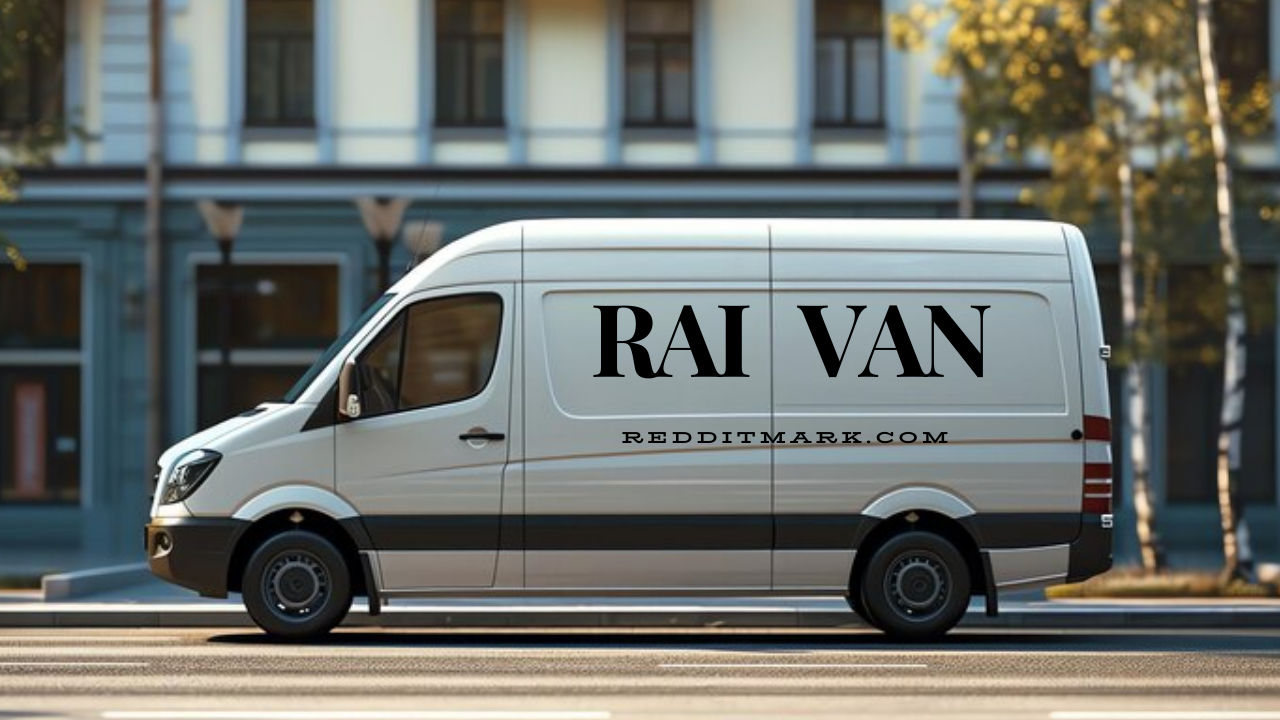Introduction
Railway vehicles, commonly known as Rai Van, are specialized automobiles designed solely for transportation on rail tracks. Originating from early rail logistics solutions, these have developed to satisfy diverse commercial and logistical wishes across numerous sectors.
Design and Structure
These Rai Vans are characterized by the aid of their robust build and precise dimensions optimized for rail delivery. These trucks generally function in a compartmentalized indoor layout, ensuring a green garage and transport of products or systems. The design emphasizes stability and safety, adhering to stringent railway requirements to resist the rigors of railway operations.
Purpose and Uses
Primarily, these function as important additives in freight logistics, facilitating the efficient movement of goods among locations. They are vital to industries consisting of manufacturing, agriculture, and logistics, presenting extensive advantages in phrases of cost-effectiveness and capability in comparison to road transport options.
Types of Rai Vans
These are categorized based totally on their capability and design specs. Variants consist of specialized trucks for transporting perishable goods, unsafe materials, and outsized shipments. Each kind is tailored to fulfill specific shipping necessities, making sure of versatility across extraordinary sectors and logistical scenarios.
Technological Advancements
Modern Vans combines advanced technologies to beautify operational performance and protection. These encompass GPS monitoring structures for actual-time place monitoring, remote diagnostics for proactive upkeep, and automated loading/unloading mechanisms. Such improvements optimize logistics operations, making these Vans crucial in modern-day freight delivery solutions.
Operational Mechanism
Operating on rail tracks requires Rai Vans to adhere to unique operational protocols. They are ready with specialized wheels and braking structures designed for top-rated overall performance on railway traces. Rigorous protection measures ensure steady transport, minimizing dangers related to rail travel and ensuring compliance with railway guidelines.
Maintenance and Upkeep
Regular protection is vital to making sure Rai Vans functions at peak overall performance stages. Maintenance practices encompass comprehensive inspections of mechanical components, lubrication of moving components, and adherence to scheduled servicing intervals. Addressing put and tear right away is critical to preserving reliability and increasing the operational lifespan of Vans.
Global Market and Manufacturers
These Vans are produced through leading manufacturers internationally to fulfill the international calls for efficient rail delivery answers. Companies that specialize in rail equipment deliver a diverse range of models tailored to local and enterprise-precise requirements. Market tendencies imply a sustained increase in the adoption of rail logistics solutions, driving non-stop innovation in Rai Van layout and manufacturing.
Environmental Impact
Efforts to mitigate environmental impact are indispensable to its design and operation. Initiatives consciousness on using eco-friendly materials, integrating energy-green technologies, and enforcing emissions-lowering measures. These Vans make a contribution to sustainable shipping solutions using minimizing carbon footprints associated with freight delivery, aligning with global environmental dreams.
Comparison with Other Rail Vehicles
Unlike locomotives or freight motors, these Vans are in particular designed for transporting smaller masses and specialized items. They complement larger rail vehicles offering flexibility and efficiency in logistics chains. This difference underscores Vans’ function in optimizing delivery chain control and improving common delivery efficiency.
Case Studies and Applications
Real-international applications of Vans exhibit their versatility and reliability throughout various operational contexts. Case research highlights successful deployments in industries ranging from agriculture and mining to retail and creation. These examples illustrate Rai Vans’ adaptability in assembling particular transport needs and contributing to streamlined logistics operations.
Environmental Sustainability
These Vans are more and more designed with environmental sustainability in mind. Manufacturers are integrating technologies and substances that lessen carbon emissions and minimize environmental effects. For example, lightweight substances and power-efficient propulsion systems assist in lower gas intake throughout transit.
Additionally, innovations in aerodynamics and regenerative braking systems contribute to lowering overall energy utilization and enhancing the eco-friendliness of Rai Vans. These advancements align with global efforts in the direction of sustainable transportation answers, making these Vans an environmentally responsible choice for freight delivery.
Innovation in safety features
Recent trends in the Rai Van era are heavily concerned with improving safety features. Advanced sensor systems are used to detect threats to abilities along the railroad tracks, allowing for preemptive moves that save you from injury. In addition, real-time monitoring of essential additives, including brake systems and wheel geometry, guarantees optimal performance and reliability during operation.
The integration of artificial intelligence and machine learning algorithms further improves predictive retention capabilities, reduces downtime, and improves the usual security requirements. These innovations underline the manufacturers’ commitment to prioritizing safety in the design and operation of the Van.
Integration with digital logistics
The virtual transformation of logistics has profoundly affected these Van’s operations. Integration with digital systems enables real-time cargo tracking and optimization of routing plans and delivery schedules. Ready with IoT (Internet of Things) devices, these Vans enable seamless verbal exchange between cars and device manipulation, increasing operational efficiency and transparency.
In addition, the statistics analysis tool analyzes transport styles and overall performance metrics, providing valuable insights for the continuous improvement of logistics management. This digital integration not only streamlines operations but also increases customer satisfaction by ensuring timely and stable delivery of products.
Adaptability to different terrains and climatic conditions
One of the amazing advantages of Rai Vans is their adaptability to different terrain and climate situations. Unlike street vans that can be affected by climate and street conditions, these Vans perform well in a variety of landscape and climate patterns. They are especially great in areas with challenging geographic features or adverse weather where rail infrastructure offers reliable and dependable delivery routes. This adaptability ensures consistent shipping schedules and minimizes disruption to supply chains, making these Vans a popular choice for long-haul shipping.
Education and training initiatives
As the complexity of the Rai Van generation increases, so does the demand for specialized educational and school applications. Manufacturers and industry stakeholders are working together to develop training modules that cover the technical components of Rai Van operation, protection, and safety protocols.
The educational project aims to provide employees with the skills and know-how necessary for the successful and competent functioning of Rai at Vans. In addition, certification applications ensure compliance with industry standards and regulatory needs and support a skilled workforce capable of handling Rai Van operations according to high-quality practices.
Economic impact and cost-effectiveness
Rai Vans plays a key role in improving monetary performance within supply chains. By leveraging the capabilities and efficiencies of rail delivery charges, businesses can reduce the logistics fees associated with long-haul freight. Rai Vans contributes to lower shipping charges in line with ton miles compared to avenue delivery options, making them a popular desire for bulk transport and specialty goods.
In addition, the scalability of rail networks enables these Vans to efficiently deal with different volumes of freight traffic, thereby promoting economies of scale and improving the underlying profitability of organizations across specific sectors.
Innovation in Autonomous Technology
Self-sustaining generation guarantees to optimize course planning and electricity consumption, improving the sustainability and fee-effectiveness of freight delivery. As research and development in self-sustaining generation continue to strengthen, these Vans are anticipated to play a primary position in the future of self-sufficient logistics solutions.
Collaboration and Industry Partnerships
Collaboration among stakeholders in the rail shipping industry is essential for driving innovation and addressing industry-demanding situations. Manufacturers, logistics companies, government organizations, and educational institutions collaborate on research initiatives to improve Rai Van’s design, safety standards, and operational performance. Industry partnerships foster information sharing and the trade of exceptional practices, main to continuous advancements in rail logistics.
Moreover, collaborative efforts promote regulatory compliance and sustainability practices, making sure these Vans meet evolving environmental and safety standards. By operating collectively, stakeholders within the rail enterprise enhance the resilience and competitiveness of the Van operations in worldwide freight shipping markets.
Regulatory Framework
Adherence to international requirements and regulatory frameworks is paramount in Rai Van’s manufacturing and operation. Compliance guarantees safety, reliability, and interoperability inside international rail networks. Regulatory bodies set up hints for design specs, operational strategies, and environmental stewardship, fostering secure and sustainable rail shipping surroundings.
Future Prospects
Future improvements in Rai Van technology promise similar upgrades in performance, safety, and environmental sustainability. Innovations along with autonomous operation systems and superior connectivity are poised to redefine rail logistics, positioning Rai Vans as indispensable components of future transport infrastructures.
Conclusion
In the end, Rai Vans plays a crucial role in modern rail logistics, providing specialized talents tailored to various industry desires. Their evolution from early designs to superior technological integrations underscores their significance in green shipment shipping on rail tracks.
FAQs
What are Rai Vans primarily used for?
Rai Vans are specialized motors designed for transporting items on rail tracks. They serve generally in freight logistics across various industries, offering efficient and fee-effective delivery answers.
How are Rai Vans distinct from traditional railcars?
These Vans are smaller and extra flexible compared to conventional railcars like locomotives and freight motors. They are designed especially for sporting smaller masses and specialized cargo, optimizing logistics performance.
What kinds of cargo are generally transported in Rai Vans?
Rai Vans transports an extensive variety of cargo, which includes perishable items, dangerous substances, oversized gadgets, and bulk commodities. Each kind of Rai Van is designed to deal with specific cargo requirements.
What safety capabilities do Rai Vans contain?
Rai Vans are prepared with specialized braking systems, superior sensor technology for impediment detection, and compliance with rigorous safety standards for rail delivery. These features make certain secure operations and reduce dangers.
How are Rai Vans maintained and serviced?
Regular upkeep of Rai Vans includes inspections of mechanical additives, lubrication of moving parts, and adherence to scheduled servicing intervals. Manufacturers and operators observe strict preservation protocols to ensure top-quality performance and reliability.
Are Rai Vans environmentally pleasant?
Efforts to lessen environmental effects are vital to the Rai Van layout. Innovations together with power-efficient propulsion structures, lightweight substances, and emissions-decreasing technology contribute to minimizing carbon footprints and selling sustainability in freight transport.
Can these be used for global freight transport?
Yes, Rai Vans are designed to function seamlessly on worldwide rail networks, facilitating move-border freight shipping. They comply with worldwide requirements and regulatory necessities, ensuring interoperability and reliability.
How does Rai Vans contribute to delivering chain performance?
Rai Vans decorates delivers chain performance by using providing reliable and cost-effective transport solutions for bulk shipment and specialized goods. Their integration into logistics networks optimizes course-making plans, reduces transportation charges, and improves shipping reliability.
What technological improvements affect the fate of Rai Vans?
Future enhancements to the Rai Van generation consist of independent operating structures, virtual connectivity for real-time monitoring, and predictive renovation capabilities. The aim of these improvements is to improve operational performance, safety, and sustainability in rail logistics.
What role does Rai Vans play in economic development?
Rai Vans drives economic improvement by facilitating green freight, reducing freight charges, and supporting industries dependent on reliable logistics solutions. They contribute to economic growth by improving connectivity and facilitating change across areas.



